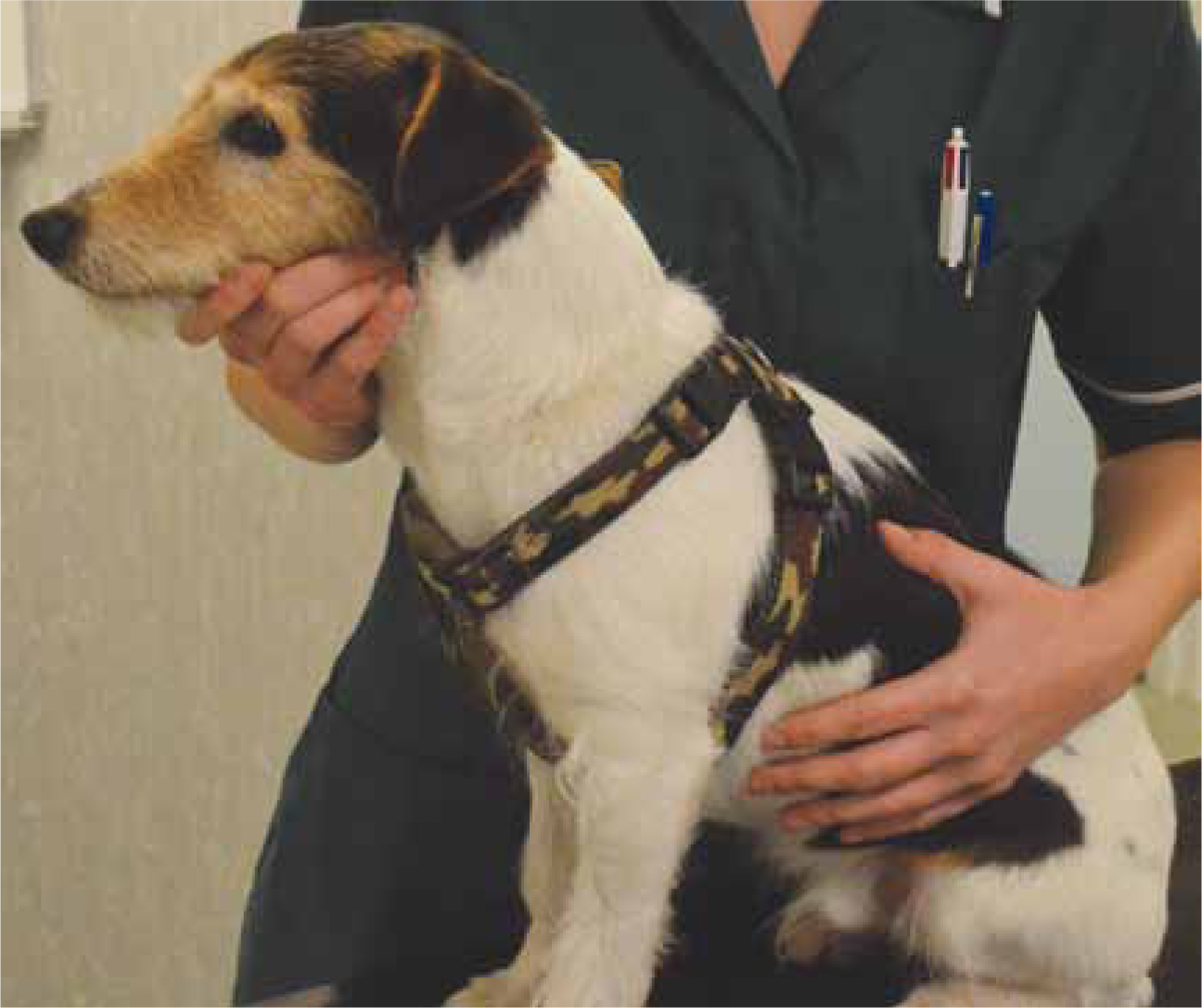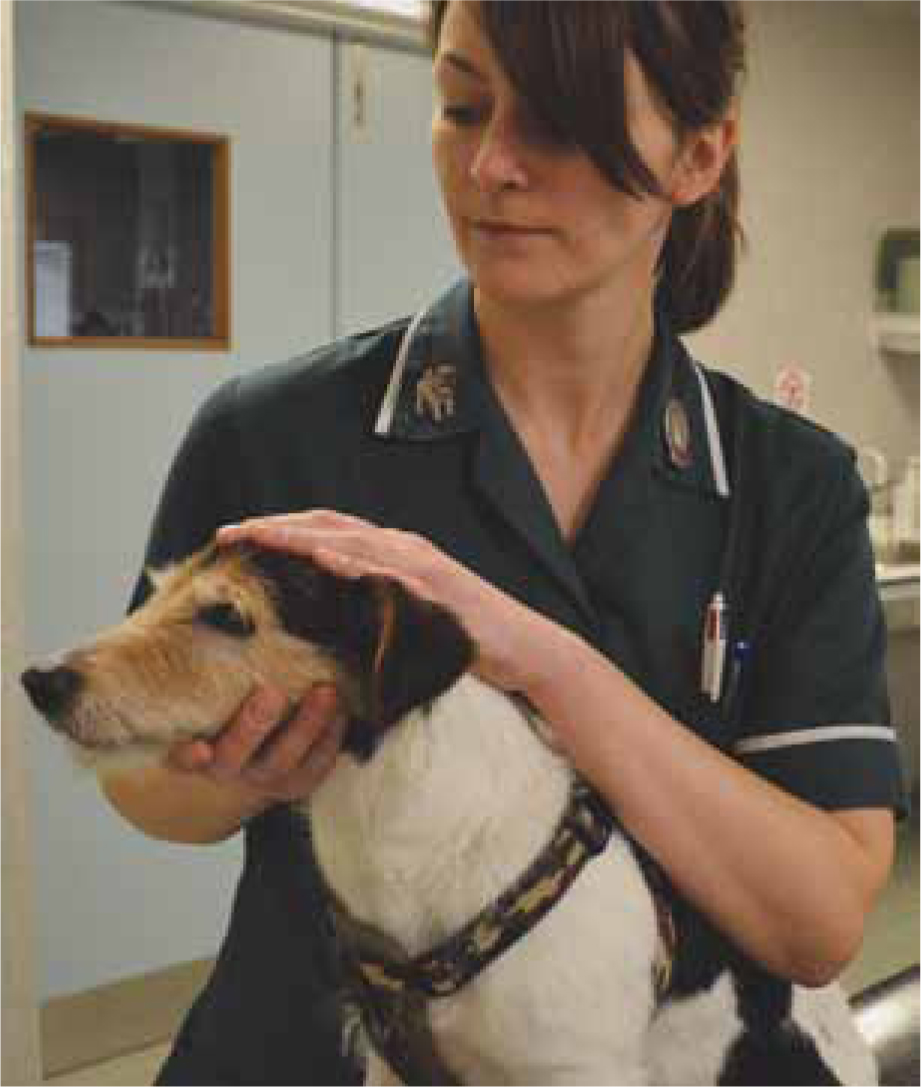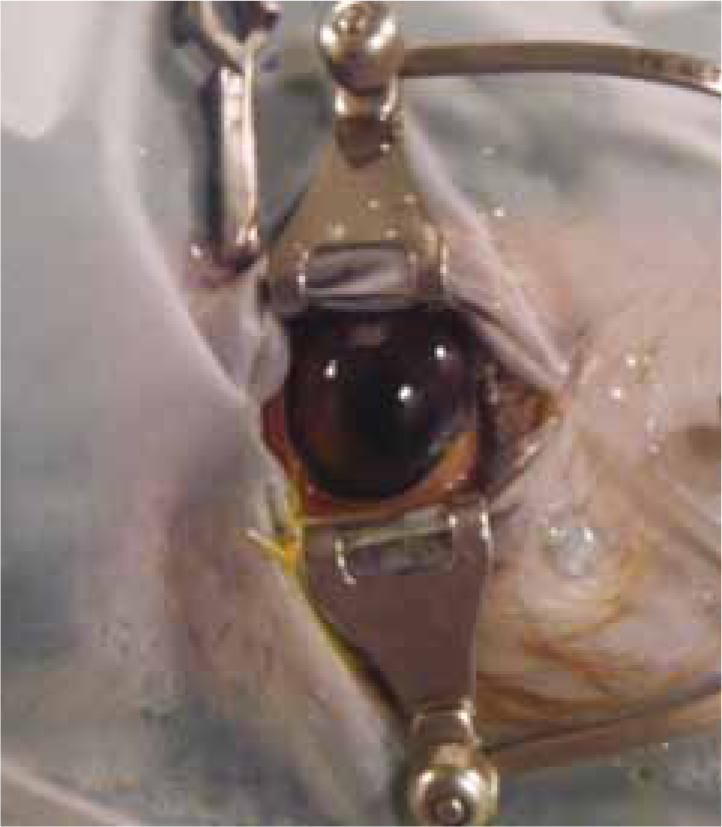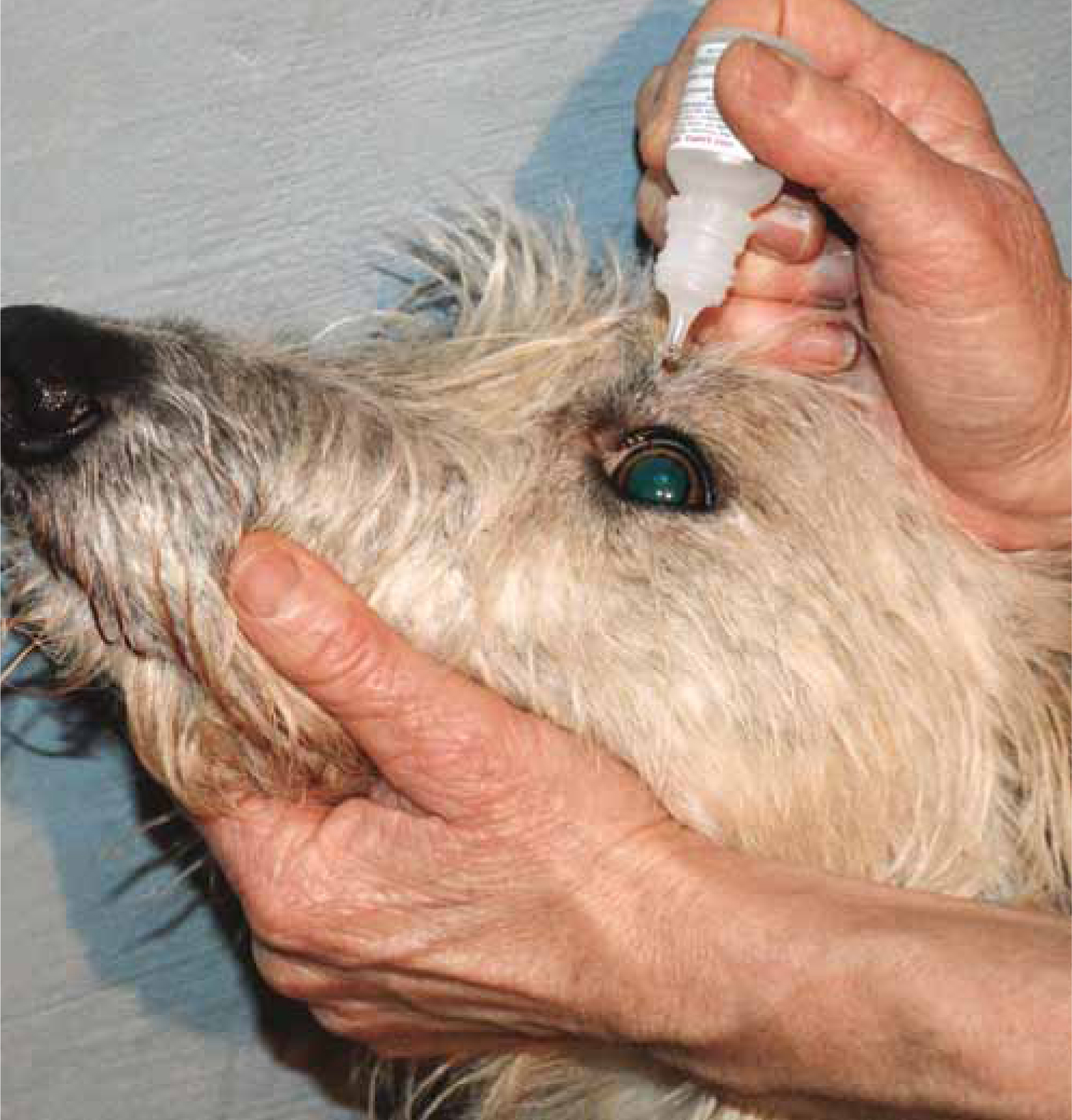As well as the general considerations for the peri-operative period there are a few specific factors to consider with the ophthalmic patient prior to surgery.
Prior to the surgery date skin and ears should be checked in the general health check. Any problems that might cause head shaking or face rubbing can then be controlled prior to surgery. This article will discuss the nursing care that is required for surgical ophthalmic patients.
Restraint
Veterinary nurses need to think carefully about restraint in the ophthalmic patient (Figures 1 and 2). An inadvertent increase in intraocular pressure due to an elevation in venous pressure by, for example straining on a collar and lead or poor manual restraint techniques, may have disastrous repercussions, such as a detrimental intraocular pressure spike in a glaucomatous patient, or a perforation in a fragile ulcerated cornea. Removal of neck collars and fitting a harness instead is highly recommended. Pauli et al (2006) have demonstrated that intraocular pressure increases significantly from baseline when pressure is applied via a collar but not via a harness. Teng et al (2003) have shown even a neck tie in humans will increase the intraocular pressure in normal and glaucomatous patients.


If a muzzle is required it should be fitted properly so that it does not get pushed up and rub on the eye.
Kennels
A calm atmosphere in the kennels is encouraged. A separate dog and cat area is ideal. Some patients may be blind and should be reassured by talking to them. A radio playing in the kennels may also be a consideration.
It is useful if the kennel area can be made darker for examination and ocular comfort as well as for dark adaptation if an electroretinogram is to be carried out.
The kennels should have no sharp protruding edges that could cause inadvertent injury.
Premedication
A calm kennel environment is helped by good premedication. Barking, coughing and vomiting will all elevate the intraocular pressure. Selection of premedication agents that avoid these complications is wise. Considerations include: opioids may induce emesis. Morphine and hydromorphone directly stimulate the vomiting centre. In painful surgical cases methadone (0.1–0.5 mg/kg for dogs, 0.1–0.2 mg/kg for cats) may be an alternative less likely to cause emesis. This is given by intramuscular injection and its effects last about 4 hours. Pethidine (1–5 mg/kg intramuscularly (IM) in dogs and cats) is a shorter acting (approximately 2 hours) alternative. Both these drugs are true agonists and their effect is dose dependent. In less painful procedures ‘weaker agents’ such as buprenorphine (partial agonist) are frequently used. Buprenorphine (0.006–0.02 mg/kg IM) has a slow onset of action (approximately 45 minutes) but duration of 6–8 hours. The level of analgesia supplied with this drug may be less reliable at higher doses or if topped up frequently. In the author's practice one of these opiods is normally combined with acepromazine (ACP) (0.01–0.05 mg/kg). This neuroleptanalgesia provides reliable sedation and reasonable analgesia as described by Turner (2005).
Diabetic dogs provide quite a large component of the cataract patients. These patients have food withheld on the morning of surgery, but free access to water. The owners are instructed to bring the animal's insulin and food with them as well as a request to bring some familiar bedding. These patients have a blood glucose level taken at premedication and half their normal insulin dose then given. In these patients in particular it should be ensured that the premedication used allows a quick recovery so these patients are up and eating as soon as possible. They are also always first on the surgical list.
Induction
Using correct manual restraint an intravenous catheter is placed. If access to the front legs is going to be difficult then the saphenous vein could be used instead. Induction and intubation should be smooth and coughing and gagging avoided by not attempting to intubate while the depth of anaesthesia is not sufficient and utilising local anaesthetic spray in cats to desensitise the larynx. Armoured tubes may be a consideration if kinking of the neck is likely for positioning and cuffed tubes required if muscle relaxant and positive pressure ventilation anticipated. The tube should be tied in place.
Preparation of the surgical site
Preparation of the surgical site is done outside the operating theatre. For intraocular surgeries no clipping is used. Clipper rash and inadvertent lid trauma is thus prevented. An ocular protectant such as carbomer (Lubrithal, Dechra) or liquid paraffin (Lacrilube, Allergan) is applied to both eyes. If required, clipping of the eyelashes can be carried out with small sharp scissors, these can have KY jelly (Johnson and Johnson) applied to them first to gather the hair. For surgeries where more clipping is required small fine toothed clippers are used. A hand held vacuum is useful for gathering stray hairs.
Surgical scrubs are not used around the eye as they are irritant to the cornea (Mac Rae et al, 1984). Chlorhexidine solutions are also irritant. Povidone-iodine 10% (Pevidine solution, various manufacturers) is recommended at a dilution of 1:10 to 1:50 with sterile saline (Roberts et al, 1986). Cotton wool soaked in the solution is used for the skin and cotton buds soaked in the solution used for in the conjunctival fornices. Take care not to inadvertently contact the cornea. The ocular surfaces can then be flushed using the diluted povidone-iodine solution. This is followed by flushing with sterile saline. Povidone–iodine solution is irritant to intraocular structures so if a corneal rupture is suspected the eye should only be prepared with sterile saline (Alp et al, 2000). An article in the human literature concluded that pre-operative povidone-iodine antisepsis was important in reducing post-surgical endophthalmitis whereas other procedures such as sub-conjunctival antibiotic injection, lash trimming, pre-operative topical antibiotics and antibiotic containing irrigating fluids appeared less so (Ciulla et al, 2002). If the procedure is bilateral a dry sterile lint-free swab can be used to protect one eye while the same procedure is carried out on the other eye.
Preparation of the globe should be gentle as external pressure on the globe can increase the intraocular pressure, cause inadvertent globe rupture or stimulate the oculo cardiac reflex which is fortunately rare in dogs and cats (Thomson, 2010).
Positioning
Vacuum packed bean bags are useful. To reduce the venous hydrostatic pressure and thus intraocular pressure table tilting so that the head is higher than the body may be useful as described by Thomson (2010).
Anaesthetic monitoring
Often the eye is inaccessible for monitoring reflexes to assess depth of anaesthesia. An oesophageal stethoscope is a very useful tool.
Neuromuscular blocking agents are frequently used in ophthalmic surgery to centrally locate the eye, relax the peri ocular muscles and reduce vitreous push. Thus intermittent positive pressure ventilation is required. Neuromuscular blocking agents do not have any effects on consciousness. Therefore attention to depth of anaesthesia is essential. As the eye will generally not be available other indicators of general anaesthetic depth must be relied on. Tachycardia, hypertension and increased end tidal CO2 may be indicators of inadequate anaesthesia as may signs of vasovagal syncope bradycardia, pallor, and hypotension, as described by Jones (2007).
Peripheral nerve stimulators can be used to measure the degree of relaxation but not of anaesthetic depth.
A blood pressure monitor, capnograph and pulse oximetry are essential if muscle relaxation is utilised and an electrocardiogram (ECG) provides useful additional information.
Most of the neuromuscular blocking agents can be reversed if required but it is important that the reversal agent is not given when the plane of anaesthesia is too deep and that adequate ventilation is continued until spontaneous breathing has resumed.
Beds that can be heated are useful. Rectal temperature should be monitored and in diabetics regular blood glucose readings taken, generally at 10 minute intervals throughout the surgery.
Surgical equipment
Ocular surgery commonly involves microsurgery and magnification in the form of loupes or an operating microscope is often used. Sterile bungs can be useful for surgeon control of the operating microscope.
Sutures used are often as small as 9–0 or 8–0 for corneal surgery and rarely bigger than 5–0 for lid surgery. Generally absorbable sutures such as Polygalactin 910 (Vicryl, Ethicon) are used thus avoiding the necessity for suture removal.
Sterile cotton buds are good swabs for microsurgery. A sticky suture pad is useful for placing used sutures on otherwise they tend to get lost.
The normal fenestrated cloth drapes for extraocular surgery are combined with sticky drapes that the veterinary surgeon can create their own incision in for intraocular surgery. These are useful when combined with the eyelid speculum for keeping hairs out of the surgical field (Figure 3).

Post-operative analgesia
As well as the relatively routine use of the non-steroidal anti-inflammatory drugs which are usually given at premedication and the opioid which is included as part of the premedication but which may be also in the post-operative regimen, other aids to analgesia are available:
Recovery period
Avoid too much coughing/gagging at extubation time by judicious use of premedication and attention to extubation time.
In the recovery ward the animal is generally placed in sternal recumbency with the head and neck extended and supported on a beanbag. If in lateral recumbency the operated eye should be uppermost.
At this stage the front dew claw(s) may be bandaged and an Elizabethan collar fitted. Someone should be dedicated to sitting with the patient to monitor recovery and calm the patient if required. A violent recovery can be catastrophic following an ocular procedure.
Procedures such as cataract surgery require frequent post-operative monitoring of intraocular pressure. Ideally this can be done with a rebound tonometer such as the TonoVet® (Kruuse) where no topical anaesthesia is required. If an applanation tonometer such as a Tono-Pen® (Avia) is used and topical anaesthesia thus required a lubricant should be applied afterwards to protect the cornea. It should be noted however that anything that increases the viscosity of the tear film can increase the readings given by an applanation tonometer by at least 25% (McLellan, 2012; personal communication).
Patient discharge
In addition to the usual instructions given to the owner on post-operative care a demonstration of the correct application of eye medications is included (Figure 4).

In animals that have had intraocular surgery advice is given that there should be no violent head shaking and therefore toys that may be ‘killed’ should be removed. Lead exercise on a harness is advisable for a time dependent on the surgical procedure carried out. The Elizabethan collar should be kept on apart from during cleaning and to check the ears and skin, again for a time dependent on procedure.
The owners should be encouraged to take note of the appearance of the eye at this stage so any adverse changes can be quickly picked up on. The owners should be instructed to contact the practice without delay if there are any concerns. It is useful to have post-operative care instructions for routine procedures and care of the blind dog/cat on a hand out. If multiple topical medications are to be given a post-operative treatment tick box sheet is also useful.
Conclusion
The management of the ophthalmic surgical patient is a team effort with owner, veterinary nurse and veterinary surgeon all playing important roles which are interdependent and reliant on each other. When this works and a painful or blind eye is transformed into a pain free or visual eye it is the most rewarding surgery.

